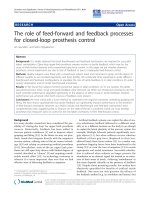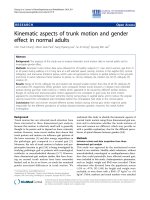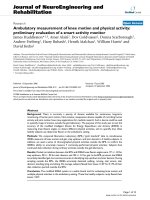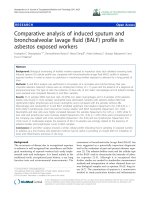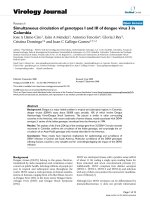báo cáo hóa học:" Controllable Synthesis of Single-Crystalline CdO and Cd(OH)2 Nanowires by a Simple Hydrothermal Approach" docx
Bạn đang xem bản rút gọn của tài liệu. Xem và tải ngay bản đầy đủ của tài liệu tại đây (401.69 KB, 5 trang )
NANO EXPRESS
Controllable Synthesis of Single-Crystalline CdO and Cd(OH)
2
Nanowires by a Simple Hydrothermal Approach
Zai-xing Yang
•
Wei Zhong
•
Yan-xue Yin
•
Xin Du
•
Yu Deng
•
Chaktong Au
•
You-wei Du
Received: 28 December 2009 / Accepted: 27 March 2010 / Published online: 11 April 2010
Ó The Author(s) 2010. This article is published with open access at Springerlink.com
Abstract Single-crystalline Cd(OH)
2
or CdO nanowires
can be selectively synthesized at 150 °C by a simple
hydrothermal method using aqueous Cd(NO
3
)
2
as precursor.
The method is biosafe, and compared to the conventional
oil-water surfactant approach, more environmental-benign.
As revealed by the XRD results, CdO or Cd(OH)
2
nanowires
can be generated in high purity by varying the time of syn-
thesis. The results of FESEM and HRTEM analysis show
that the CdO nanowires are formed in bundles. Over the
CdO-nanowire bundles, photoluminescence at *517 nm
attributable to near band-edge emission of CdO was recor-
ded. Based on the experimental results, a possible growth
mechanism of the products is proposed.
Keywords CdO Á Cd(OH)
2
Á Nanowires Á Hydrothermal Á
Photoluminescence
Introduction
One-dimensional (1-D) nanostructures, such as nanowires,
nanorods, nanotubes, and nanobelts, have received wide
attention in the field of nanoscience [1]. With unique
physical properties that are size- and shape dependent, the
materials are expected to play a critical role in the tech-
nologies of future electronic and optoelectronic devices [2].
1-D structures of semiconductor materials such as Si [3],
Ge [4], GaN [5], GaAs [6] as well as those of ZnO, SnO
2
,
In
2
O
3
and CdO [7] are frequently reported in the literature.
They are produced by various methods including vapor-
phase transport [5], chemical vapor deposition [8], arc
discharge [9], laser ablation [6], solution [10] and template-
based method [11].
Cadmium oxide (CdO) is an important n-type semi-
conductor with a direct band gap of 2.5 eV and an indirect
band gap of 1.98 eV [12]. The difference in band gap
originates from cadmium and oxygen vacancies and
strongly depends on the procedures of synthesis [13].
Because of the large linear refractive index (n
0
= 2.49),
CdO is a promising candidate for optoelectronics applica-
tions and can be used in the fabrication of solar cells,
phototransistors, photodiodes, transparent electrodes, cat-
alysts and gas sensors [14–17]. In the past decade, CdO of
multifarious 1-D nanostructures (such as nanowires [18],
octahedrons and nanowires on micro-octahedrons [19],
porous nanobelts [20], nanoneedles [21], and nanostrands
[1]) have been synthesized and studied. However, the
reported CdO nanostructures were produced through the
use of a sacrificial template. Jia et al. [20] obtained CdO
nanostructures by calcining shape-controlled single-crys-
talline CdCO
3
. With heating in the presence of oxygen at
high temperatures, Zhang et al. [18] prepared CdO nano-
wires from a layered metalorganic framework assembled
by 1-D infinite zigzag chains. It is noted that efficient
synthesis of 1-D CdO nanostructures using one-step, tem-
plate-free, and seedless method is rare.
Cadmium hydroxide, Cd(OH)
2
, is a wide band gap
semiconductor with a wide range of possible applications
Z. Yang Á W. Zhong (&) Á X. Du Á Y. Deng Á Y. Du
Nanjing National Laboratory of Microstructures and Department
of Physics, Nanjing University, 210093 Nanjing,
People’s Republic of China
e-mail:
C. Au
Chemistry Department, Hong Kong Baptist University,
Hong Kong,
People’s Republic of China
Y. Yin
Laser Institute, Qufu Normal University, 273165 Qufu,
People’s Republic of China
123
Nanoscale Res Lett (2010) 5:961–965
DOI 10.1007/s11671-010-9589-y
including solar cells, photo transistors and diodes, trans-
parent electrodes, sensors, cathode electrode materials of
batteries, and so forth [15, 22–24]. The applications of
Cd(OH)
2
are based on its specific optical and electrical
properties. For example, Cd(OH)
2
films show high elec-
trical conductivity as well as high transparency in the
visible region of solar spectrum. Cadmium hydroxide has
also been proven to be an important precursor that can be
converted into cadmium oxide through dehydration or into
other functional materials (e.g., CdS, CdSe) by reaction
with appropriate elements or compounds [25].
Herein, we report a simple hydrothermal method for the
preparation of single-crystalline CdO or Cd(OH)
2
nano-
wires. The approach is efficient and simple and does not
involve the use of a template. The synthesis was conducted
at 150 °C using aqueous Cd(NO
3
)
2
as the only precursor.
By varying the synthesis time, the growth of CdO and
Cd(OH)
2
can be selectively controlled. To the best of our
knowledge, the fabrication of CdO or Cd(OH)
2
nanowires
in such a way has never been reported.
Experimental Details
For the synthesis of single-crystalline CdO and Cd(OH)
2
nanowires, 0.1 M Cd(NO
3
)
2
Á2H
2
O was dissolved in
deionized water to form a 40.0-mL solution that was
transferred into a Teflon-lined autoclave. The autoclave
with its content was kept in an oven at 150 °C for 10 h,
24 h, or 48 h. At the end of the hydrothermal treatment, the
as-obtained solid material was separated from the yellow
turbid solution using a centrifuge and thoroughly washed
with absolute ethanol and deionized water (three cycles).
The reagents used in the experiments were of analytical
grade (purchased from Nanjing Chemical Industrial Co.)
and used without further purification.
The samples were examined on an X-ray powder dif-
fractometer (XRD) at room temperature (RT) for phase
identification using Cu Ka radiation (Model D/Max-RA,
Rigaku, Japan). The morphologies of the samples were
examined over a high-resolution TEM (HRTEM, model
JEOL-2010, Japan) operated at an accelerating voltage of
200 kV and a field-emission scanning electron microscope
(FESEM model FEI Sirion 200, America) operated at an
accelerating voltage of 5 kV. The photoluminescence (PL)
of samples was measured at RT using a He–Cd laser
(excitation source: 325 nm).
Results and Discussion
The X-ray diffraction (XRD) results of the samples col-
lected at 10, 24, and 48 h are shown in Fig. 1. The peaks of
the 24-h sample (Fig. 1b) are indexed to cubic phase of
CdO with lattice constants of a = b = c = 0.4725 nm
(JCPDS No. 78-0653). We find that the 48-h sample
(Fig. 1c) is mainly Cd(OH)
2
, while the 10-h one is com-
posed of CdO and Cd(OH)
2
. Based on the results, one can
see that there is the conversion of Cd(NO
3
)
2
Á2H
2
Oto
Cd(OH)
2
in the initial hours of synthesis plausibly by
means of hydrolysis (Eq. 1). After 24 h, CdO is formed,
likely a result of Cd(OH)
2
decomposition (Eq. 2). At
around 48 h, it is found that Cd(OH)
2
is the predominant
product. The inter-transformation of CdO and Cd(OH)
2
will be discussed later in this article. It is proposed that the
as-prepared bundles of Cd(OH)
2
nanowires can be used as
a template for fabricating porous cadmium chalcogenides
nanomaterials.
2Cd NO
3
ðÞ
2
Á2H
2
O ! 2Cd OHðÞ
2
þ4NO
2
þ O
2
þ 2H
2
O
ð1Þ
Cd OHðÞ
2
! CdO þ H
2
O ð2Þ
The morphology and size of the as-synthesized (150 °C,
24 h) CdO-nanowire bundles were characterized by FE-
SEM and HRTEM. According to Fig. 2a, the yield of CdO
wires (tens of micrometers in length) is high. One can see
that the wires are comprised of several nanowires that
bundle together, and the average diameter of the wires is
around 40 nm (Fig. 2b, c). In addition, detected also are
nanostrands of smaller size which could be considered
as ‘‘building blocks’’ for the formation of the nanowire
bundles. The HRTEM image (Fig. 2d) indicates that the
CdO nanowires are single-crystalline, showing spacing
(0.273 nm) corresponding to the (111) plane of CdO. In
Fig. 1 XRD patterns of samples collected after a 10 h, b 24 h and c
48 h of hydrothermal treatment at 150 °C
962 Nanoscale Res Lett (2010) 5:961–965
123
EDX analysis, only Cd and O are detected over the as-
synthesized CdO bundles (Fig. 2e). It is apparent that
bundles of single-crystalline CdO nanowires can be fabri-
cated by this simple method of hydrothermal synthesis.
Shown in Fig. 3 are the FESEM and TEM images of the
10-h and 48-h samples. Over the 10-h sample, one can
detect the presence of nanowires that are in the process of
gathering into bundles (Fig. 3a–c). As for the 48-h sample
(Fig. 3d–f), the FESEM and TEM images differ signifi-
cantly from those of the 10-h (Fig. 3a–c) and 24-h (Fig. 1)
samples. The 48-h sample is comprised of wires that are
much shorter in length (Fig. 3d) and with ends that are
cuspidated (Fig. 3e). We find that the wires of the 48-h
sample readily decompose into nanoparticles during
HRTEM analysis (Fig. 3f). It is known that Cd(OH)
2
nanowires easily decompose to porous CdO nanowires
upon heat treatment [26]. The decomposition of the 48-h
sample during HRTEM analysis could be a result of elec-
tron bombardment. The result of SAED analysis shows that
the 10-h and 48-h samples are single-crystalline. Indicated
by arrows in Fig. 3b,e are the positions from where the
SAED patterns were taken. At the 10th hour, the product is
a mixture of CdO and Cd(OH)
2
, and the SAED pattern is
similar to that of 24-h Cd(OH)
2
.
Despite the exact growth mechanism of the CdO-nano-
wire bundles is not clear, one can make hypotheses based
on the obtained data. As indicated by the XRD results, the
reaction processes in different reaction periods can be
Fig. 2 FESEM images of the
as-fabricated CdO wires at
a low and b high
magnifications; c TEM image of
a bundle of CdO nanowires;
d HRTEM image of nanowires
that make up the bundle; and
e EDX spectrum of the
as-prepared nanostructures
Fig. 3 a FESEM, b TEM images and c SAED pattern of the 10-h sample. d FESEM, e TEM and f HRTEM images of the 48-h sample. Inset e is
the SAED pattern
Nanoscale Res Lett (2010) 5:961–965 963
123
different. At the initial stage, because of the release of NO
2
during the hydrolysis of Cd(NO
3
)
2
Á2H
2
O (Eq. 1), the for-
mation of cadmium hydroxide nuclei is promoted. From
these nuclei, Cd(OH)
2
compounds gather to form nanost-
rands (can be observed clearly in Fig. 2c) of high aspect
ratios as demonstrated elsewhere [27–30]. As shown in
Fig. 4, the nanostrands could serve as building blocks for
the formation of ordered nanostructures. As reported by
Shinde et al. [31] with the availability of ionic species,
nanoparticles accumulated on the positive nanostrands,
resulting in the generation of nanowire bundles. Under the
adopted hydrothermal conditions, the nanostrands are in
the course of assembling into bundles at the 10th hour
(Fig. 4). With the dehydration reaction, bundles of single-
crystalline CdO nanowires are obtained at the 24th hour.
However, Cd(OH)
2
nanowires are obtained at the 48th
hour. The inter-transformation of CdO and Cd(OH)
2
could
be explained as follows. In the reaction bath, there are
Cd
2?
,NO
3
-
,OH
-
,H
?
,NO
2
,H
2
O, and O
2
. Because of the
continuous release of NO
2
, there is decrease in NO
3
-
concentration. It is worth pointing out that besides existing
as gas in the autoclave, NO
2
dissolves in H
2
O as well as
indicated by the turbid solution that is yellow in color. To
keep neutrality of the reaction system, the amount of OH
-
should increase. As a result, the reaction gradually shifts
toward the formation of Cd(OH)
2
during the later hours,
making Cd(OH)
2
being the major product. In other words,
despite of the fact that the reactions of Eqs. 1 and 2 are
reversible, and normally the product should be a mixture of
CdO and Cd(OH)
2
, high-purity CdO and Cd(OH)
2
can be
generated, respectively, at the 24th and 48th hour, as
indicated by the results of XRD investigation.
Shown in Fig. 5 are the photoluminescence (PL) spectra
of the 10-h and 24-h samples. The 24-h bundles show a
strong emission peak at *517 nm ascribable to the near
band-edge emission of CdO. The 10-h sample exhibits an
excitonic peak at *512 nm, showing a modest blue-shift
(*5 nm) compared to the corresponding peak of the 24-h
sample. The weak emissions detected in both cases are
likely to be due to impurities and/or various kinds of
defects. With such strong emission peak at *517 nm, the
CdO-nanowire bundles can be utilized in the industry of
high-quality monochromatic laser.
Conclusion
In conclusion, we have demonstrated that by means of a
facile, low-cost, and template-free approach, bundles of
single-crystalline CdO nanowires can be hydrothermally
fabricated at 150 °C using aqueous Cd(NO
3
)
2
as precursor.
We find that CdO and Cd(OH)
2
can be selectively obtained
Fig. 4 Schematic of the
formation of nanowire bundles
Fig. 5 PL spectra of bundles of nanowires collected after a 10 h and
b 24 h of hydrothermal treatment
964 Nanoscale Res Lett (2010) 5:961–965
123
according to synthesis time. The as-synthesized CdO
bundles show strong 517-nm emission and hence can be
utilized in the manufacture of gas sensors. Also, the 48-h
product can act a good template for the fabrication of CdS
and CdO nanostructures. It is envisioned that this simple
and low-cost approach can be adopted for the synthesis of
nanostrucures of other oxides (such as ZnO, FeO) using the
corresponding nitrates as precursors.
Acknowledgments We would like to acknowledge the Foundation
of National Laboratory of Solid State Microstructures, Nanjing Uni-
versity (Grant No. 2010ZZ18), the National High Technology
Research and Development Program of China (Grant No.
2007AA021805), and the National Key Project for Basic Research
(Grant No. 2005CB623605), People’s Republic of China for financial
support.
Open Access This article is distributed under the terms of the
Creative Commons Attribution Noncommercial License which per-
mits any noncommercial use, distribution, and reproduction in any
medium, provided the original author(s) and source are credited.
References
1. M.F. Ye, H.Z. Zhong, W.J. Zheng, R. Li, Y.F. Li, Langmuir 23,
90649 (2007)
2. W. Lu, C.M. Lieber, J. Phys. D Appl. Phys. 39, R387 (2006)
3. J.T. Hu, T.W. Odom, C.M. Lieber, Acc. Chem. Res. 32, 435
(1999)
4. Y. Wu, P. Yang, Chem. Mater. 12, 605 (2000)
5. C.C. Chen, C.C. Yeh, Adv. Mater. 12, 738 (2000)
6. X.F. Duan, C.M. Lieber, Adv. Mater. 279, 208 (2000)
7. T.J. Kuo, M.H. Huang, J. Phys. Chem. B 110, 13717 (2006)
8. M. Yazawa, M. Koguchi, A. Muto, M. Ozawa, K. Hiruma, Appl.
Phys. Lett. 61, 2051 (1992)
9. Y.C. Choi, W.S. Kim, Y.S. Park, S.M. Lee, D.J. Bae, Y.H. Lee,
G.S. Park, W.B. Choi, N.S. Lee, J.M. Kim, Adv. Mater. 12, 746
(2000)
10. J.D. Holmes, K.P. Johnson, R.C. Doty, B.A. Korgel, Science 287,
1471 (2000)
11. Y. Li, G.W. Meng, L.D. Zhang, F. Philipp, Appl. Phys. Lett. 76,
2011 (2000)
12. Y.Z. Zhang, G.L. Wang, Mater. Lett. 62, 673 (2008)
13. A. Gulino, G. Tabbi, A.A. Scalisi, Chem. Mater. 15, 3332 (2003)
14. R. Ferro, I.A. Rodriguez, Sol. Energy Mater. Sol. Cells 64, 363
(2000)
15. M. Ristic, S. Poporic, S. Music, Mater. Lett. 58, 2494 (2004)
16. T.K. Subramanyam, S. Uthanna, N.B. Srinivasulu, Mater. Lett.
35, 214 (1998)
17. A.K. Srivastava, S. Pandey, K.N. Sood, S.K. Halder, R. Kishore,
Mater. Lett. 62, 727 (2008)
18. F. Zhang, L. Bei, J.M. Cao, X. Wang, J. Solid State Chem. 181,
143 (2008)
19. T. Ghoshal, S. Biswas, P.M.G. Nambissan, G. Majumdar, S.K.
De, Cryst. Growth Des. 9(3), 1287 (2009)
20. Z.Y. Jia, Y.W. Tang, L.J. Luo, B.H. Li, Cryst. Growth Des. 8(7),
2116 (2008)
21. X.L. Liu, C. Li, S. Han, J. Han, C.W. Zhou, Appl. Phys. Lett. 82,
12 (2003)
22. H. Zhang, X.Y. Ma, Y.J. Ji, J. Xu, D.R. Yang, Mater. Lett. 59,56
(2005)
23. S. Motupally, M. Jain, V. Srinivasan, J.W. Weidner, J. Electro-
chem. Soc. 145, 34 (1998)
24. B. Tang, L.H. Zhuo, J.C. Ge, J.Y. Niu, Z.Q. Shi, Inorg. Chem. 44,
2568 (2005)
25. H.Z. Zhong, Y.C. Li, Y. Zhou, C.H. Yang, Y.F. Li, Nanotech-
nology 17, 772 (2006)
26. Z. Guo, M.Q. Li, J.H. Liu, Nanotechnology 19, 245611 (2008)
27. I. Ichinose, K. Kurashima, T. Kunitake, J. Am. Chem. Soc. 126,
7162 (2004)
28. Y.H. Luo, J. Huang, I. Ichinose, J. Am. Chem. Soc. 127
, 8296
(2005)
29. I. Ichinose, J. Huang, Y.H. Luo, Nano Lett. 5, 97 (2005)
30. Y.H. Luo, J. Huang, J. Jin, X. Peng, W. Schmitt, I. Ichinose,
Chem. Mater. 18, 1795 (2006)
31. V.R. Shinde, H.S. Shim, T.P. Gujar, H.J. Kim, W.B. Kim, Adv.
Mater. 20, 1008 (2008)
Nanoscale Res Lett (2010) 5:961–965 965
123



